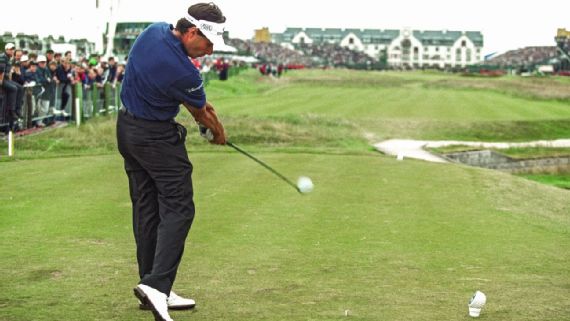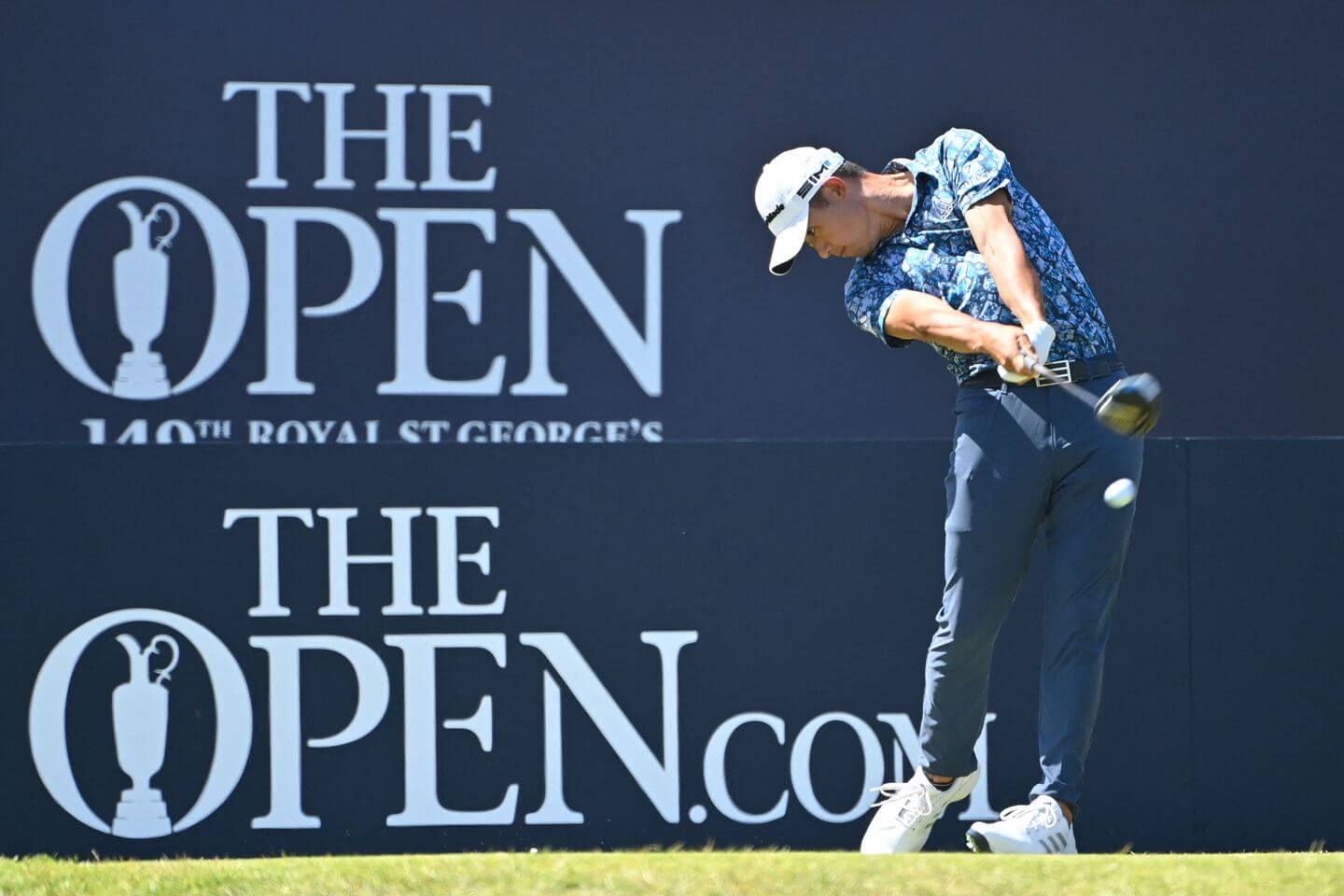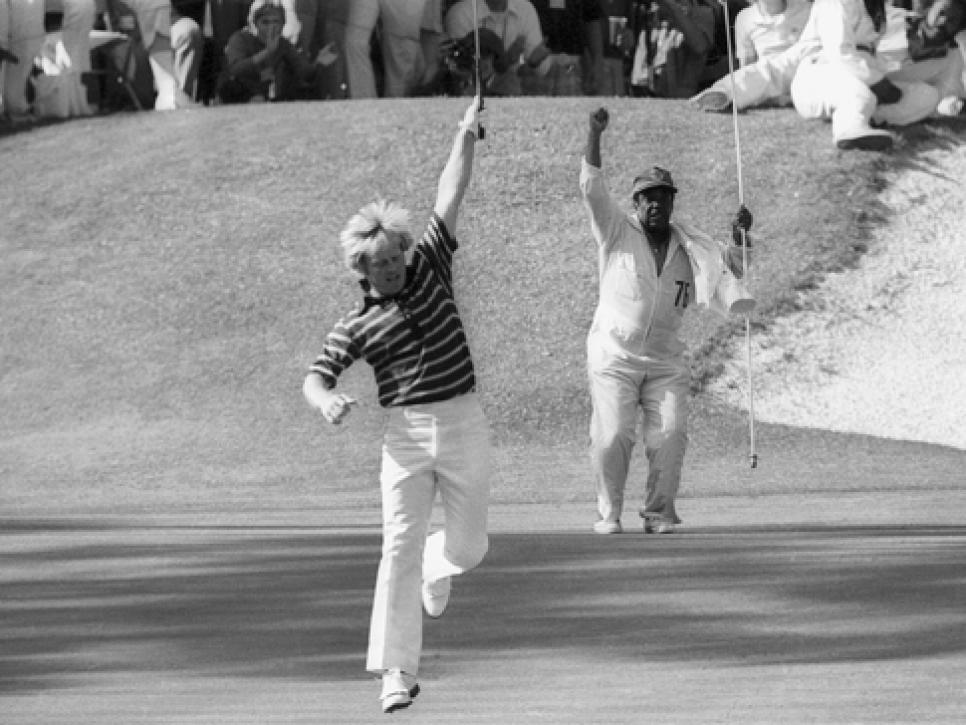Perhaps no player in history is more intertwined with a golf hole than Jean van de Velde and the 18th at Carnoustie during the 1999 Open Championship.
Leading by three strokes standing on the 18th tee at the 499-yard par-4 home hole, Van de Velde needed only a double bogey to win the Claret Jug. He could have played a wedge all the way in. Instead, a comedy of errors ensued and the 33-year-old journeyman became the victim of golf’s biggest misfortune.
Van de Velde was attempting to become the first Frenchman to win golf’s oldest championship since Arnaud Massy in 1907. He arrived in Scotland as the 152nd-ranked player in the world. Notoriously the most difficult of the ten courses used in the British Open rota, Car-nasty was brutal during the third weekend in July 1999. Hard by the North Sea, the layout presented thick, damp rough and howling winds. Nineteen-year-old Sergio Garcia, who had just turned pro and was coming off his first win at the Irish Open earlier that month, went straight from the course crying into his mother’s arms after shooting 89 and 83 in the first two rounds. “It was the hardest test of golf I’d ever seen in my life,” said two-time U.S. Open winner Curtis Strange, who was covering the Open Championship for ABC Sports.
An unknown coming into the 128th Open Championship, Van de Velde seemed impervious to the conditions and led after the second and third rounds before taking a five-shot cushion into the final day. Despite having only one European Tour win to his credit, the slender Frenchman was in complete control. ABC analyst Steve Melnyk described the final round scene as “a story of fairytale proportions.” Standing on the 18th tee on Sunday, the coronation was almost complete.
“Golf is a sport and a game: nothing more, and nothing less. The adversity you face when playing it is an opportunity to find out who you really are, and what you are made of.”
Carnoustie’s 18th fairway is bisected twice by the Barry Burn, a creek which snakes back on itself into the nearby North Sea. After holing out for par on 17, Van de Velde strolled to 18 holding a three-shot lead. He had birdied 18 twice during the first three rounds. As ABC’s on-course commentator and 1958 PGA Champion Bob Rosburg says to Strange on air, “Curtis, he’s got a three-shot lead, I’ve got to play an iron” — Van de Velde pulls the headcover off his driver.
Van de Velde hit a wayward drive that was fortunate to clear the burn and ended up on an island near the 17thfairway. Rather than laying up, he inexplicably hit a two-iron in an attempt to go for the green. The ball hit one of the railings in the grandstand before careening 50 yards backward into thick, knee-deep rough. Rather than play his third into the fairway, wedge on and two-putt for victory, Van de Velde went for the green. “This is so, so sad,”uttered BBC announcer Peter Allis. “And so unnecessary.” On his third shot, Van de Velde’s club got tangled on his downswing and the ball plopped into the deep channel of the Barry Burn. “The real mistake is on the third shot,” the Frenchman recalled. “I tried to go forward. The only thing you need to avoid is putting it in the water.”
Van de Velde removed his shoes and socks, rolled up his pantlegs, and gingerly stepped into shin-deep water as he debated whether to try and play his ball out of the burn. As a light rain began to fall, the situation became a tragicomedy. When it appeared Van de Velde was going to play from the water, Allis told viewers, “This is beyond a joke now, he’s gone gaga.”
As it unfolded, Van de Velde appeared to find some humor in his own collapse. Though he looked like he was making light, he was burning up inside, saying later, “I was mad, sad, everything combined.” He smiled in response to a comment made by his playing partner, Craig Parry, who, trying to ease the stress of the situation, jokingly suggested that they wait until the tide go out so Van de Velde could get a better lie.
The channel was connected to the sea, and during the time it took for Van de Velde to assess the situation the rising tide had covered his ball. Within five minutes, the ball was completely submerged. “I couldn’t hit it out of there,” he said later, “there was no way.” Van de Velde took a drop from behind the burn, then chipped his fifth shot into a greenside bunker, where it came to rest next to Parry’s ball. “He’s just compounding it,” whispered Rosburg. “Error after error mentally.”
Van de Velde is a stunning example of how to behave the right way when things go wrong.
In another dramatic twist, Perry holed it from the sand. Van de Velde needed to follow suit for his six and a victory. He blasted to eight feet, then faced a knee-knocker for a triple bogey seven. “You root against no one, you root for no one,” said Mike Tirico to a TV audience watching with baited breath. “But you’ve got to hope that this goes in.” It did, dropping Van de Velde into a three-way playoff with Paul Lawrie and Justin Leonard. But the drama on the 72nd hole had taken its toll on the stunned Van de Velde, who would finish three-over in the four-hole playoff. Lawrie, who had come from ten shots back on the final day, would eventually triumph for the only major win of his career.
In the aftermath of the worst moment of his professional life in front of the entire golf world, Jean Van de Velde made no excuses. He was a model of grace and dignity. “I’m going to have to live with it, not you guys.” he told a swarm of reporters afterward.
Heart-breaking and excruciating to watch, Van de Velde’s meltdown was more painful than those suffered at Augusta by Greg Norman in 1996, Rory McIlroy in 2011, or Jordan Spieth in 2016. Those were car crashes that unfolded in super-slow motion over the course of the round. Van de Velde’s was different, in that it was sudden. And it was extreme. Little known before the Open Championship, he forever became a symbol of disaster on the golf course. The image of his haunted face beneath a white visor, trousers rolled up above his knees while contemplating playing out of the water is seared in the collective memory.
While Jean Van de Velde’s meltdown at the 1999 Open Championship is the biggest one-hole collapse in major championship history, the resilient Frenchman leaves a legacy of humility, perspective and charity.
Born May 22, 1966, in Mont-de-Marson, in the southwest of France, Jean Van de Velde won three amateur events before turning pro in 1987. He joined the European Tour in 1989 and captured his first win at the 1993 Roma Masters. Van de Velde twice finished in the top 20 of the Order of Merit [the European Tour’s money list] and collected seven wins as a professional. The slender Frenchman played on the PGA Tour in 2000 and 2001, where his best finish was a second after losing to Scott Verplank in a playoff at the 2000 Reno-Tahoe Open.
A member of the 1999 European Ryder Cup Team, Van de Velde represented France in six Dunhill Cup matches and a dozen World Cup events. He played in 14 majors, making nine cuts and recording three Top-20 finishes. In the new millennium, Van de Velde was beset by injuries for several years before making a dramatic comeback at the 2005 Open de France, where he lost in a playoff to fellow countryman Jean-Francois Remesy. He rebounded to claim his second and last European Tour title at the 2006 Madeira Island Open before retiring from professional golf in 2008.
Following his dramatic loss at the Open, Jean Van de Velde returned to France having slowly lost his grip on a childhood dream. At his home course in Mont-de-Marsan, the local schoolchildren were invited out every Wednesday for a free golf clinic. The event always drew 15 to 20 attendees. Despite the painful outcome, Van de Velde’s performance at the Open Championship became a source of pride in his homeland. At the restart of school two months after his collapse at Carnoustie, 120 kids showed up at the clinic. “They went from 15 to 120,” explained Van de Velde, “because they all wanted to play golf because of what happened to me.”
Jean Van de Velde is two decades removed from his collapse at Carnoustie, and time has brought him perspective. “Golf is a large part of me but it doesn’t make me who I am as a human being.” Mr. Van de Velde was extremely influential in the Ryder Cup coming to France for the first time in September 2018. Since 2012, the father of four has been an ambassador for UNICEF, using golf to raise funds for initiatives in poverty-stricken Madagascar.









